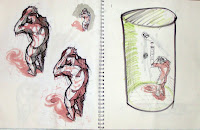
John Hood-Taylor: Dystopia
Friday, October 8 · 8:00pm - 10:00pm
P&H Cafe
1532 Madison Ave
Memphis, TN 38104
(901) 726-0906
Dystopia, the antithesis of Utopia, deals with my views on the current social turmoil of our country. Although we live in a land of freedom and opportunity, at times it seems somewhat constrained and isolating. Utopia can exist only in the mind. Once one(s) try to express this ideal in the physical world does the processes become disruptive and culminate in a sort of fracture of the established goal.
 Project Sketchbook 2010: The Exhibition
Project Sketchbook 2010: The Exhibition
Friday, October 8 · 6:00pm - 10:00pm
Adam Shaw Studio
2547 Broad Avenue
Memphis, TN
The results of Project Sketchbook 2010 will be on display for two weeks opening Friday, October 08, 2010 from 6-10pm at Adam Shaw's Studio on Broad Avenue. Come join us!
Check out
http://www.projectsketchbook2010.com/ for details.
Work from: Anastasia Nabakowski, Mary Jo Kamrimnia, AJ Karpinski, Adam Remsen, Alec McIntyre, Alex Paulus, Ariel Claborne, Ashley Luyendyk, Ashley Odum, Baxter Bucks, Beverly Dorsey, Brett Edmonds, Candace Canerdy, Cara Dailey, Caroline Mitchell, Charlie Touvell, Cheri Biggers, Christopher Reyes, Claire M. Ryan, Colin Kidder, Daniel Felt, Darlene Newman, Derrick Dent, Dorothy Spencer, Elaine Miller, Elizabeth Alley, Ellen Mitchell, Gina Burcky, Greg Langford, Gregg Haller, Jen Russell, Jennifer Absher, Jennifer Barnett-Hensel, Jeremiah Mills, Jill C. Denton, Joel Priddy, John Hood-Taylor, Jonathan Payne, Jonathan Postal, Kandice Cook, Lauren Rae Holtemrmann, Lisa Maners, Lisa Tribo, Marilyn Califf, Matthew Pierson, Matthew Roberson, Megan Travis-Carr, Michael Kline, Michele Duckworth, Miriam Oliphant, Moe Seki, Molly Young, Pamela McFarland, Rebecca Shellaberger, Roann Mathia, Robert Pearce, Ruth McElroy, Santana Singleton, Shane McDermott, Siphne Sylve, Stephanie Miller, Susan Younger, T. Matthew Pierson, Lindsay C. Workman, Tiffany Futch, Trici Parker, Vicki Murdock, Vincent Nappi, AND MORE!
 Gadsby Creson: 40 Bike Rack Maquettes
Gadsby Creson: 40 Bike Rack Maquettes
Friday, October 8 · 6:00pm - 8:00pm
Urban Art Commission
2549 Broad Ave
Memphis, TN 38112
(901) 454-0474
Friday October 8 will be the opening night of the second exhibition in the UrbanArt exhibition series, Work in Progress, highlighting innovative urban design in the public realm. The second exhibition in the series, 40 Bike Rack Maquettes, is recent work by native Memphian, Gadsby Creson. This series of maquettes explores the opportunity to create functional and innovative designs for bike racks. The artist's hope is that the maquettes will eventually be used as blueprints for bike racks around the City of Memphis. Creson earned her Bachelors of Fine Arts degree from Tufts University/School of the Museum of Fine Arts and is currently a candidate for a Masters of Fine Arts degree at Memphis College of Art.
The opening for 40 Bike Rack Maquettes will be held on Friday October 8 from 6 - 8 PM at the UrbanArt office on Broad Avenue. The exhibition will last from October 8, 2010 through January 28, 2011. Viewings of the exhibition after opening night will be by appointment only. To schedule an appointment to view the exhibition after the opening, please contact info@urbanartcommission.org

MCA faculty, student, and alumni exhibit during the Broad Ave. Artwalk!
Friday, October 8 · 5:00pm - 10:00pm
West Memorials
2481 Broad Ave
Memphis, TN 38112



























